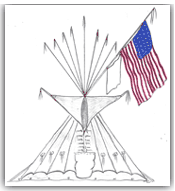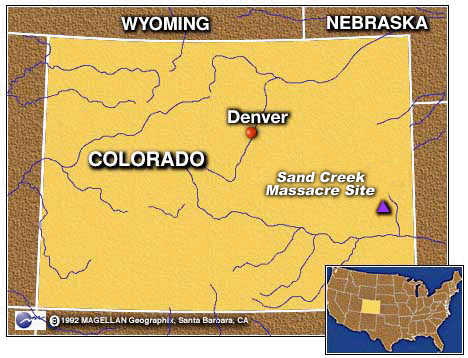|
|
Canku Ota |
|
|
(Many Paths) |
||
|
An Online Newsletter Celebrating Native America |
||
|
May 4 , 2002 - Issue 60 |
||
|
|
||
|
Sand Creek Healing Can Begin |
||
|
by Katie Kerwin
McCrimmon, Rocky Mountain
News Staff Writer
|
||
|
|
 The
ghosts of Sand Creek may finally rest in peace. The
ghosts of Sand Creek may finally rest in peace.
The healing at the massacre site in southeastern Colorado may begin now that a private donor is paying $1.5 million to purchase a privately owned ranch where U.S. soldiers slaughtered 163 Native Americans 138 years ago. Most of those killed were unarmed women and children. The soldiers dismembered their victims and paraded around Colorado with body parts and scalps as trophies. "We never imagined that we could ever come back to Colorado and have the opportunity to repossess a place where our people were massacred in 1864," said Robert P. Tabor, chairman of the Cheyenne and Arapahoe Tribes of Oklahoma. For Native Americans, Sand Creek is like the hallowed ground at the World Trade Center. "It's a similar feeling to what the terrorists have done to all of us. We have been carrying this feeling for over a century. Each time we think of it, it touches us very deeply," Tabor said. "This will give us an opportunity as individuals and as a tribe to go there and mourn," Tabor said. "It's a healing process that we're going to start after more than a century. That process will actually begin once we are the owners of the land and we are able to walk there freely. "We can't measure (the gift). It's so tremendous." After decades of controversy over the site, a private casino company has stepped in and resolved the matter in less than a month. Jim Druck is the president of Southwest Casinos, a Minnesota-based company. His company manages casinos in Oklahoma for the Cheyenne and Arapahoe tribes. Druck lives in Colorado and also owns three casinos in Cripple Creek. Druck has visited the Sand Creek site and been deeply moved by the horror of what took place there. He compared it to the Nazi concentration camps now preserved in Germany. When Druck learned from one of his managers that William Dawson, the owner of the 1,465-acre ranch east of Eads, was planning to sell his land to the highest bidder, Druck stepped in. The federal government had been trying to buy the land but was not willing to pay Dawson's price. Druck convened a conference call with his board members and 30 minutes later, they decided to purchase the land and hand it over to the Cheyenne and Arapahoe Indian tribes. The purchase will be final within three months. The tribes then plan to work with the National Park Service to convert the land into part of the 12,470-acre Sand Creek Massacre Historic Site, which already has been approved by Congress.
|
||||||
|
|
||
|
|
||
| Canku Ota is a free Newsletter celebrating Native America, its traditions and accomplishments . We do not provide subscriber or visitor names to anyone. Some articles presented in Canku Ota may contain copyright material. We have received appropriate permissions for republishing any articles. Material appearing here is distributed without profit or monetary gain to those who have expressed an interest. This is in accordance with Title 17 U.S.C. Section 107. | ||
|
Canku Ota is a copyright © 2000, 2001, 2002, 2003 of Vicki Lockard and Paul Barry. |
||
 |
 |
|
|
The "Canku Ota - A Newsletter Celebrating Native America" web site and its design is the |
||
|
Copyright © 1999, 2000, 2001, 2002, 2003 of Paul C. Barry. |
||
|
All Rights Reserved. |
||
